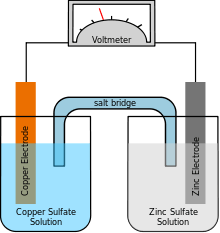Potassium-ion battery
A potassium-ion battery or K-ion battery (abbreviated as KIB) is a type of battery and analogue to lithium-ion batteries, using potassium ions for charge transfer instead of lithium ions. It was invented by the Iranian/American chemist Ali Eftekhari (President of the American Nano Society) in 2004.
Prototype
The prototype device used a potassium compound Prussian blue as the cathode material[1] for its high electrochemical stability.[2] The prototype was successfully used for more than 500 cycles. A recent review showed currently that several pragmatic materials have been successfully used as the anode and cathode for the new generations of potassium-ion batteries.[3]
Advantages
Along with sodium-ion battery, potassium-ion battery is the prime candidate to replace lithium-ion batteries.[4] The potassium battery has certain advantages over similar lithium batteries (e.g., lithium-ion batteries): the cell design is simple and both the material and the fabrication procedure are cheaper. The key advantage is the abundance and low cost of potassium in comparison with lithium, which makes potassium batteries a promising candidate for large scale batteries such as household energy storage and electric vehicles.[5] Another advantage of potassium-ion battery over lithium-ion battery is the possibility for charging faster.[6] This means that the next generation of mobile phones based on potassium-ion batteries can be charged within a few minutes only. [7]
The prototype employed a KBF
4 electrolyte though almost all common electrolyte salts can be used. In addition, ionic liquids have also recently been reported as stable electrolytes with a wide electrochemical window.[8][9]The chemical diffusion coefficient of K+
in the cell is higher than that of Li+
in lithium batteries, due to a smaller Stokes radius of solvated K+
. Since the electrochemical potential of K+
is identical to that of Li+
, the cell potential is similar to that of lithium-ion. Potassium batteries can accept a wide range of cathode materials which can offer rechargeability lower cost. One noticeable advantage is the availability of potassium graphite, which is used as an anode material in some lithium-ion batteries. Its stable structure guarantees a reversible intercalation/de-intercalation of potassium ions under charge/discharge.
Applications
In 2005, a potassium battery that uses molten electrolyte of KPF
6 was patented.[10][11] In 2007, Chinese company Starsway Electronics marketed the first potassium battery-powered portable media player as a high-energy device.[12]
Potassium batteries have been proposed for large-scale energy storage given its exceptional cycleability.[13][14]
Biological Potassium Battery
The interesting and unique feature of potassium-ion battery in comparison with other types of batteries is that the life on the planet is somehow based on biological potassium-ion batteries. K+ is the key charge carrier in plants. Circulation of K+ ions facilitates the energy storage in plants by forming decentralized potassium batteries.[15] This is not only an iconic feature of potassium-ion batteries but also indicates how important it is to understand the role of K+ charge carriers to understand the living mechanism of plants.
Other Potassium Batteries
Researchers demonstrated a potassium-air (K−O2) battery with low overpotential. Its charge/discharge potential gap of about 50 mV is the lowest reported value in metal−air batteries. This provide round-trip energy efficiency of >95%. In comparison, Li-O2 batteries have a much higher overpotential of 1–1.5 V, which results in 60% round-trip efficiency.[16]
See also
- List of battery types
- Lithium-ion battery
- Sodium-ion battery
- Lithium–air battery
- Thin-film battery
- Rechargeable electricity storage system
References
- ↑ Eftekhari, A (2004). "Potassium secondary cell based on Prussian blue cathode". Journal of Power Sources. 126: 221. Bibcode:2004JPS...126..221E. doi:10.1016/j.jpowsour.2003.08.007.
- ↑ Itaya, K; Ataka, T; Toshima, S (1982). "Spectroelectrochemistry and electrochemical preparation method of Prussian Blue modified electrodes". Journal of the American Chemical Society. 104 (18): 4767. doi:10.1021/ja00382a006.
- ↑ Eftekhari, A; Jian, Z; Ji, X (2017). "Potassium Secondary Batteries". ACS Applied Materials & Interfaces. 9 (5): 4404. doi:10.1021/acsami.6b07989.
- ↑ "New battery concept: potassium instead of lithium". 8 October 2015.
- ↑ "High-Capacity Aqueous Potassium-Ion Batteries for Large-Scale Energy Storage". 2 December 2016.
- ↑ "Potassium Ions Charge Li Batteries Faster". 20 January 2017.
- ↑ "Researchers reveal 'supercharger' battery breakthrough that could lead to phones that charge in minutes". 18 January 2017.
- ↑ "Physicochemical and Electrochemical Properties of K[N(SO2F)2]–[N-Methyl-N-propylpyrrolidinium][N(SO2F)2] Ionic Liquids for Potassium-Ion Batteries". 7 August 2017.
- ↑ "Rechargeable potassium-ion batteries with honeycomb-layered tellurates as high voltage cathodes and fast potassium-ion conductors". 20 September 2018.
- ↑ US 20090263717 Ramasubramanian, M; Spotnitz, RM
- ↑ US 2005017219 Li, W; Kohoma, K; Armand, M; Perron, G
- ↑ Melanson, D (24 October 2007). "China's Starsway touts potassium battery-powered PMP". Engadget. Retrieved 2011-09-16.
- ↑ "New Battery Technology Could Provide Large-Scale Energy Storage for the Grid". 25 November 2011.
- ↑ "Battery electrode's 40,000 charge cycles look promising for grid storage". 22 November 2011.
- ↑ Gajdanowicz, Pawel (2010). "Potassium (K+) gradients serve as a mobile energy source in plant vascular tissues". Proceedings of the National Academy of Sciences of the United States of America. 108 (2): 864. Bibcode:2011PNAS..108..864G. doi:10.1073/pnas.1009777108. PMC 3021027.
- ↑ "A Low-Overpotential Potassium−Oxygen Battery Based on Potassium Superoxide".
